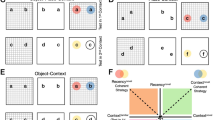Abstract
The effects of fornix lesions were examined in an object recognition memory test based on spontaneous exploration. In the standard condition an object (A) was presented in the sample phase and then presented again in the test phase alongside a new object (B). Both fornix-transected (Fx) and control (Co) rats spent more time exploring the new object than the familiar object after retention delays of 1 min and 15 min. In two configural conditions designed to test sensitivity to reconfigured stimuli, the original sample (A) was now either re-presented alongside its rearranged version (∀), or the re-arranged version itself (∀) was presented with a new object (B). In the first configural condition, both the Co and Fx rats spent more time exploring the reconfigured sample (∀) than the original version of the sample (A) following a delay of 1 min, but not 15 min. In the second configural condition, both Co and Fx rats spent more time exploring the new object (B) than the reconfigured version of the sample (∀) following a delay of 15 min but not 1 min. These present results do not support Sutherland and Rudy's hypothesis on hippocampal function; however, they demonstrate that memory of objects as well as memory of reconfigured objects could easily be examined in a test based on spontaneous exploratory behaviour.
Similar content being viewed by others
References
Aggleton JP, Hunt PR, Rawlins JNP (1986) The effects of hippocampal lesions upon spatial and nonspatial tests of working memory. Behav Brain Res 19 133–146
Alvarado MC, Rudy JW (1992) Some properties of configural learning: an investigation of the transverse patterning problem. J Exp Psychol Animal Behav Processes 18:145–153
Davidson TL, McKernan MG, Jarrard LE (1993) Hippocampal lesions do not impair negative patterning: a challenge to configural association theory. Behav Neurosci 107:227–234
Ennaceur A, Delacour J (1988) A new one-trial test for neurobiological studies of memory in rats. 1. Behavioural data. Behav Brain Res 31:47–59
Ennaceur A, Meliani K (1992) A new one-trial test for neurobiological studies of memory in rats. 3. Spatial vs non spatial working memory. Behav Brain Res 51:83–92
Gallagher M, Holland PC (1992) Preserved configural learning and spatial learning impairments in rats with hippocampal damage. Hippocampus 2:81–88
Mumby DG, Wood ER, Pinel JPJ (1992) Object-recognition memory is only mildly impaired in rats with lesions of the hippocampus and amygdala. Psychobiology 20:18–27
Nadel L (1991) The hippocampus and space revisited. Hippocampus 1:221–229
Nadel L (1992) Multiple memory systems: what and why. J Cogn Neurosci 4:179–188
Olton DS, Becker JT, Handelmann GE (1979) Hippocampus, space and memory. Behav Brain Sci 2:313–365
O'Keefe J, Nadel L (1978) The hippocampus as a cognitive map. Clarendon Press, Oxford
Pearce JM, Wilson PN (1990) Configural associations in discrimination learning. J Exp Psychol Animal Behav Processes 16:250–261
Rasmussen M, Barnes CA, McNaughton BL (1989) A systematic test of cognitive mapping, working memory, and temporal discontiguity theories of hippocampal function. Psychobiology 17:335–348
Rawlins JNP (1985) Associations across time: the hippocampus as a temporary memory store. Behav Brain Sci 8 479–528
Reynolds GS (1961) Attention in pigeons. J Exp Anal Behav 4:203–208
Riccio DC, Ackil J, Burch-Vernon A (1992) Forgetting of stimulus attributes: methodological implications for assessing associative phenomena. Psychol Bull 112:433–445
Rothblat LA, Vneck N, Gleason TC, Kromer LF (1993) Role of the parahippocampal region in spatial and non spatial memory: effects of parahippocampal lesions on rewarded alternation and concurrent object discrimination learning in the rat. Behav Brain Res 55:93–100
Shaw C, Aggleton JP (1993) The effects of fornix and medial prefrontal lesions on delayed non-matching-to-sample by rats. Behav Brain Res 54:91–102
Sutherland RJ, Rudy JW (1989) Configural association theory: the role of the hippocampal formation in learning, memory, and amnesia. Psychobiology 17:129–144
Sutherland RJ, McDonald RJ, Hill CR (1989) Damage to the hippocampal formation in rats selectively impairs the ability to learn cue relationships. Behav Neural Biol 52:331–356
Whishaw IQ, Tomie J (1991) Acquisition and retention by hippocampal rats of simple, conditional, and configural tasks using tactile and olfactory cues: implications for hippocampal function. Behav Neurosci 105:787–797
Whishaw IQ, Tomie J, Kolb B (1992) Ventrolateral prefrontal cortex lesions in rats impair the acquisition and retention of a tactile-olfactory configural task. Behavioral Neurosci 106:597–603
Wilson PN, Pearce JM (1992) A configural analysis for feature-negative discrimination learning. J Exp Psychol Animal Behav Processes 18:265–272
Author information
Authors and Affiliations
Rights and permissions
About this article
Cite this article
Ennaceur, A., Aggleton, J.P. Spontaneous recognition of object configurations in rats: effects of fornix lesions. Exp Brain Res 100, 85–92 (1994). https://doi.org/10.1007/BF00227281
Received:
Accepted:
Issue Date:
DOI: https://doi.org/10.1007/BF00227281




